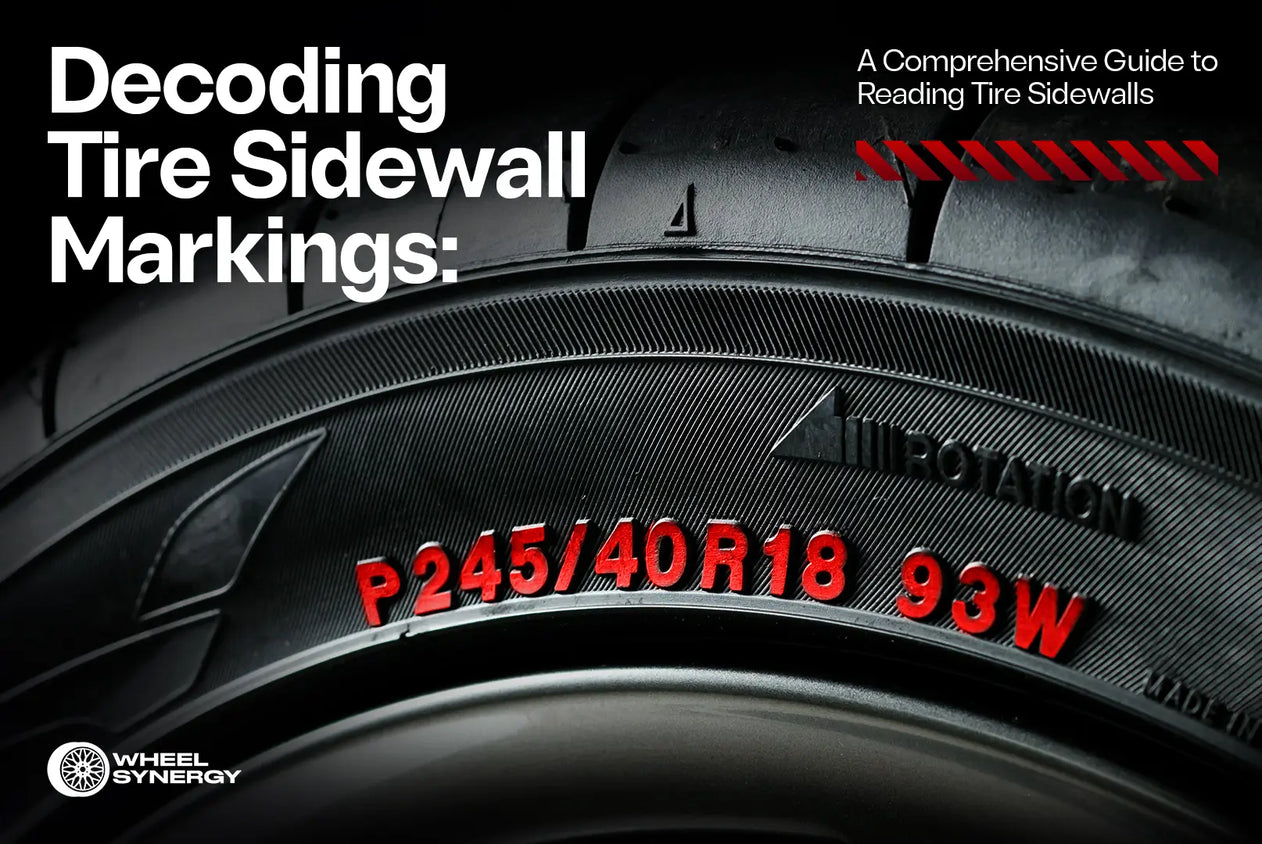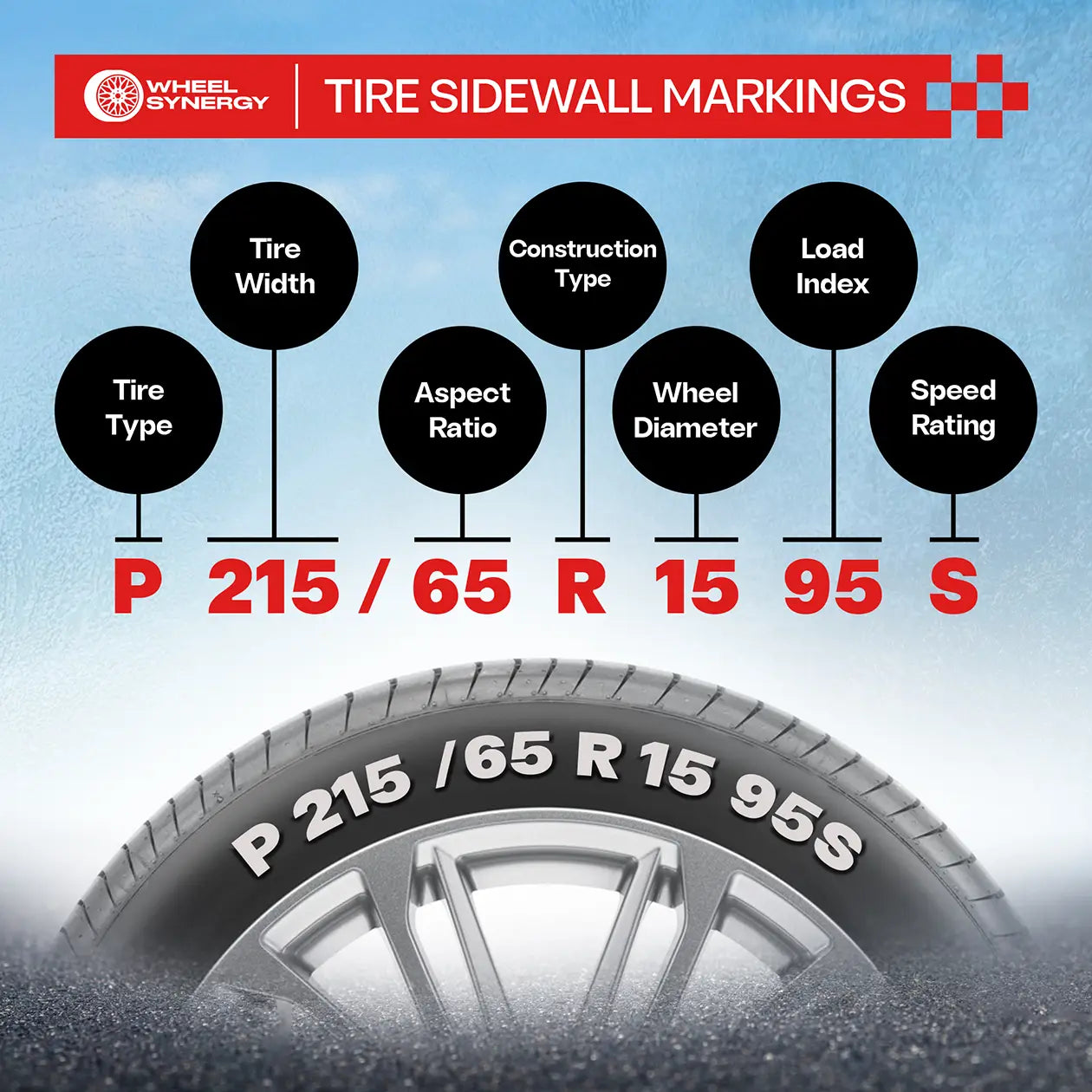Your cart is empty.




MON - FRI: 9:00AM - 5:30PM (EST)
SAT: 9:00AM - 3:00PM (EST)

Have you ever looked at your tire’s sidewall and wondered what the alphanumeric markings on it mean? The sidewall contains crucial information about the tire size, load capacity, speed rating, and understanding these markings is essential for maintaining and selecting the right tires for your vehicle.
In this comprehensive guide, we will walk you through the process of decoding tire sidewall markings, which will enable you to make informed decisions and ensure optimal performance and safety of your wheels.

The tire size is typically the first piece of information you'll encounter on the sidewall. It is expressed in a standardized format like P215/65R15. Here's what each element of the tire size means:
Understanding tire size helps you choose the right replacement tires and maintain proper compatibility with your vehicle.
Next, you'll find two additional alphanumeric codes representing the tire's load-carrying capacity and speed rating. For example, a code like 95S means:
"95" corresponds to the load index, indicating the maximum load capacity the tire can handle, which in this case is 690 kg.
"S" represents the speed rating, indicating the maximum speed at which the tire can operate safely, which in this case is 180 km/h.
Consult your vehicle's manual to ensure that the load index and speed rating of your tires are suitable for your driving needs.
| Load Index | Kilograms | Load Index | Kilograms | Load Index | Kilograms |
|---|---|---|---|---|---|
| 65 | 290 | 80 | 450 | 95 | 690 |
| 66 | 300 | 81 | 462 | 96 | 710 |
| 67 | 307 | 82 | 475 | 97 | 730 |
| 68 | 315 | 83 | 487 | 98 | 750 |
| 69 | 325 | 84 | 500 | 99 | 775 |
| 70 | 335 | 85 | 515 | 100 | 800 |
| 71 | 345 | 86 | 530 | 101 | 825 |
| 72 | 355 | 87 | 545 | 102 | 850 |
| 73 | 365 | 88 | 560 | 103 | 875 |
| 74 | 375 | 89 | 580 | 104 | 900 |
| 75 | 387 | 90 | 600 | 105 | 925 |
| 76 | 400 | 91 | 615 | 106 | 950 |
| 77 | 412 | 92 | 630 | 107 | 975 |
| 78 | 78 | 93 | 650 | 108 | 1000 |
| 79 | 437 | 94 | 670 |
| Speed Symbol | Approx MPH | Approx KM/H |
|---|---|---|
| Q | 99 | 160 |
| R | 106 | 170 |
| S | 112 | 180 |
| T | 118 | 190 |
| H | 131 | 210 |
| V | 149 | 240 |
| VR | 131 | 210 |
| W | 168 | 270 |
| Y | 186 | 300 |
| ZR | 149 | 240 |
The sidewall often features three important ratings related to treadwear, traction, and temperature resistance. These ratings are denoted by three-letter codes:
Consider these ratings when selecting tires that align with your driving style and environmental conditions.
The "DOT" symbol certifies the tire manufacturer's compliance with the U.S. Department of Transportation (DOT) and provides details about the tire’s manufacturing date and location. Displayed as a string of numbers and letters (which looks something like DOTXXXXXXXX1121) is information about when your tire was manufactured. The last four numbers relate to the date of manufacture, so you can identify the age of your tire. In this example, the date code is 1121 which would mean that the tire was manufactured in the 11th week of 2021.
The sidewall of the tire often displays the tire manufacturer's name, logo, or brand. Additionally, you may find the tire model or series name, which provides specific details about the tire's design, intended use, or performance characteristics. Recognizing the manufacturer’s information helps you identify the tire's origin and reputation.
By understanding how to read the sidewall of a tire, you gain valuable insights into your tire’s specifications and capabilities. Decoding the tire size, load capacity, speed rating, treadwear, traction, temperature ratings, and manufacturer information enables you to select the right tires for your vehicle, ensuring optimal performance, safety, and longevity.